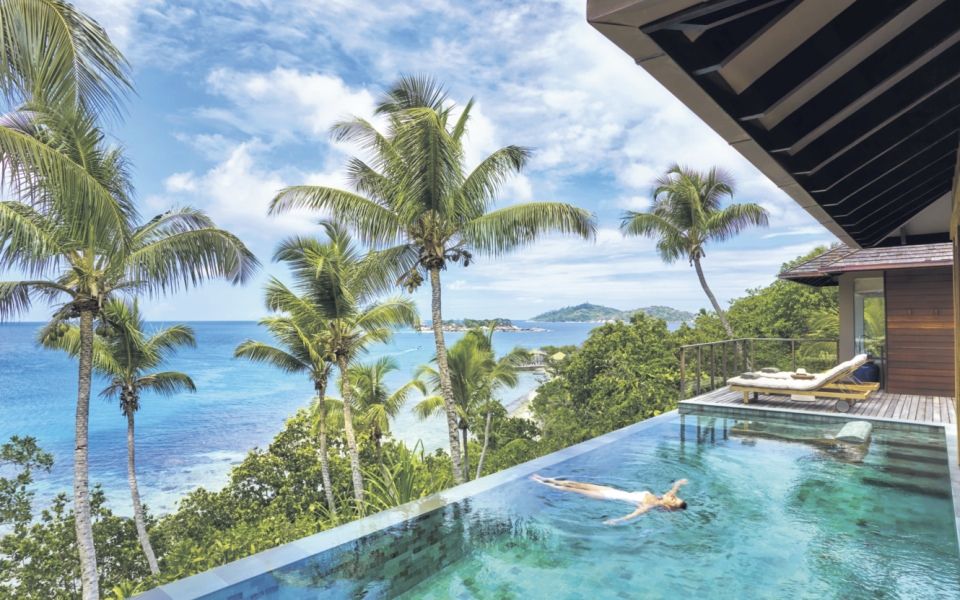Six Senses Zil Pasyon: The Seychelles island resort that’s reintroducing native wildlife to the surrounding environment

Two of Felicite island’s landscape gardeners wave as they scoot past me in their electric tractor, and I am caught, yet again, intently photographing giant boulders. I’m becoming obsessed.
I’ve been on this Indian Ocean island hideaway a few days already, but still I’m captivated by its ancient rocks. They have the all the drama and character of the iconic stone heads of Easter Island, yet their stark granite humps are untouched by the hand of man, carved over millions of years by the elements into slitted mouths, rounded backs and striated armour. If the world suddenly shook, they would surely awaken, rise and amble off.
These rocks, our waymark as the pilot and I arrive by helicopter from the main island of Mahe, form the unique natural architecture of the island’s only occupier, Six Senses Zil Pasyon (Isle of Passion) resort and residences. The British architects constructing the 30-villa resort have sensitively incorporated these monsters, creating a sense of space and privacy, the palm trees, natural vegetation and landscaping softly contrasting with their eternal solidity.
And I am right to be awestruck. For these rocks have a story to tell, which unfolds as I hike to the uplands with South African ecologist Steve Hill. Sporting Crocodile Dundee-style tropic-wear and brimmed hat, Steve knows everything there is to know about Seychellois flora and fauna.

He explains that the rocks stand out so starkly against the lush greenery not only because of their size but because the granite heats up in the equatorial sun to such a degree that plants and lichen cannot live on them. And to understand their origins gives a clue to the uniqueness of the Seychelles archipelago.
These rocks are the exposed remnants of the southern hemisphere supercontinent, Gondwana, predating Pangaea. These are the only oceanic granite islands on the planet, hundreds of millions of years old, in existence when life was merely primordial soup.
Re-establishing the natural ecology of neighbouring Fregate Island, with its population of free-roaming native giant tortoises, was a project Steve had worked on for more than a decade. With that under his belt, he has brought his encyclopaedic knowledge to Felicite.
His work here started a decade ago, but the global economic downturn caused the total redevelopment of the former resort to stall. Steve and his small team of Kenyan landscapers managed to carry on while the future of the island hung in the balance.
Eventually Six Senses took it on, and Steve is a fan of their long-term, softly-softly approach to returning the island to its roots. As he says: “The ecology of the island is being painstakingly restored using my local knowledge and the now tried-and-tested methodology to re-establish wildlife habitats on a larger scale.”
Six Senses Zil Pasyon, barefoot luxury at its high-design, low-impact best, is now fully open, with the completion earlier this year of its spectacular ocean-view spa constructed within and around, of course, a jaw-dropping giant boulder field.
Rates for a Seychelles private island experience can run into several thousand pounds per night, but Zil Pasyon compares very favourably with the rest (although food and drink are, as usual, “reassuringly expensive”).
The private residences, 28 in total, are in gradual, phased construction. These, plus the resort – comprising two small-scale restaurants, a bar, kids’ club, landscaped infinity pool, lounge terrace, lawns, boutique, library, adventure centre plus beaches with secret hammocks and oversized lanterns wafting droplets of light from ancient branches – will cover fully one-third of the island. The rest is newly established Seychellois habitat, now actively growing.

The next step is to start the long process of re-introducing the endemic birds that have long since vanished from Felicite. The first re-introduction will be the Seychelles paradise flycatcher, to be followed by the Seychelles magpie robin, the Seychelles white-eye, Seychelles fody and Seychelles warbler.
It has been arduous work over many years to remove the alien plant species that dominated the island. On our hike, which Steve regularly joins when his schedule permits it, we ramble to our destination: a tropical glade with giant rocks, lush ferns and soaring palm trees. Bark and dry leaves crunch underfoot. I can smell the humidity. Bees buzz.
If you have been to the Seychelles archipelago, you will know of its famous coco de mer nut. Shaped like buttocks, it is the largest seed in the world and is highly prized. Where most people see it growing is in the UNESCO Vallee de Mai on the larger island of Praslin.
In this remote glade the coco de mer trees grow wild and tall, clusters of pendulous nuts hanging high among the giant leaves of the female palms, the equatorial sunlight casting dramatic shadows down through the fronds.
For nature lovers, another treat lies in store off the beaten track – an exhilarating 40-minute speedboat ride from Felicite to an island few tourists visit, Aride.
Uninhabited, except for six or seven researchers, included in your landing fee is a hike amid the forests with one of the rangers, who will show you plump white-tailed tropic birds nesting on the ground and clouds of frigatebirds roosting on the cliffs.
Steve calls Aride “the seabird citadel of the Indian Ocean”, hopefully they will one day be joined by many more.
Carrier offers 7 nights for the price 6 in a Hideaway Pool Villa from £4,555 per person on a bed and breakfast basis.
Price includes return flights with Emirates from Heathrow and return transfers via private helicopter.
To find out more call 0161 492 1358 or visit carrier.co.uk. Book by 25 September.